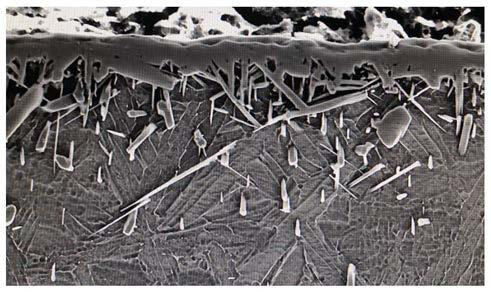Biphase boron-titanium composite layer
A composite layer, boron-titanium technology, applied in the field of wear-resistant infiltration layer, can solve the problems of low efficiency, coarse structure, difficult phase control, etc., and achieve the effect of improving deposition quality
- Summary
- Abstract
- Description
- Claims
- Application Information
AI Technical Summary
Problems solved by technology
Method used
Image
Examples
Embodiment 1
[0039] This embodiment provides a dual-phase boron-titanium composite layer, which is prepared in the following manner:
[0040] Step 1) Surface treatment of titanium alloy substrate
[0041] 1) Degreasing: Mix the metal detergent and water to prepare a solution with a concentration of 5%, raise the temperature to 58°C, immerse the titanium alloy substrate in the metal detergent solution, soak for 1.5 hours to remove oil;
[0042] 2) Surface grinding: the surface of the washed titanium alloy substrate is sequentially polished with 400#, 600#, 800#, 1000#, 1200#, 1500#, 2000# water-grinding sandpaper;
[0043] 3) Ultrasonic cleaning: first use acetone as a cleaning agent, and use an ultrasonic cleaning machine to clean the surface-polished titanium alloy substrate at room temperature for 40 minutes; then use deionized water as a cleaning agent, and use ultrasonic cleaning for 40 minutes;
[0044] 4) Plasma cleaning: place the titanium alloy substrate in a PVD device, evacuate ...
Embodiment 2
[0056] This embodiment provides a dual-phase boron-titanium composite layer, which is specific to that of Embodiment 1 only in that:
[0057] In step 4), "heat to 960°C" is replaced with "heat to 980°C".
[0058] The TC4 sample after boronizing is detected by scanning electron microscope (SEM). The thickness of the boronizing layer is 50-65um. The boronizing layer on the surface of the sample is dense, well wedged with the substrate, and the growth direction is perpendicular to the substrate.
Embodiment 3
[0060] This embodiment provides a dual-phase boron-titanium composite layer, which is specific to that of Embodiment 1 only in that:
[0061] Use "cold spray" to replace "PVD method" to deposit pure titanium layer;
[0062] Specifically: the process conditions of cold spraying pure titanium prefabricated layer: nitrogen pressure (40~60bar), flow rate (80~95 cubic meters / minute), temperature (950~1100 degrees Celsius), powder feeding amount (50~70g / min) , Carrier gas pressure (5~20bar), carrier gas flow rate (1~9 cubic meters / min), spraying distance (15~35mm).
[0063] The TC4 sample after boronizing is detected by scanning electron microscope (SEM). The thickness of the boronizing layer is 60-80um. The boronizing layer on the surface of the sample is dense and well wedged with the substrate, and the growth direction is mostly perpendicular to the substrate.
PUM
| Property | Measurement | Unit |
|---|---|---|
| thickness | aaaaa | aaaaa |
| particle size | aaaaa | aaaaa |
| thickness | aaaaa | aaaaa |
Abstract
Description
Claims
Application Information
 Login to View More
Login to View More - R&D
- Intellectual Property
- Life Sciences
- Materials
- Tech Scout
- Unparalleled Data Quality
- Higher Quality Content
- 60% Fewer Hallucinations
Browse by: Latest US Patents, China's latest patents, Technical Efficacy Thesaurus, Application Domain, Technology Topic, Popular Technical Reports.
© 2025 PatSnap. All rights reserved.Legal|Privacy policy|Modern Slavery Act Transparency Statement|Sitemap|About US| Contact US: help@patsnap.com



